You may know the feeling of being out on a hike when you turn a corner and find a long snake basking in the sun on the trail. Usually, a second later, it quickly slithers away into the protective surroundings. Snakes move differently than caterpillars; they don’t inch along like inchworms either. Are they just one long muscle, or how do they move? Do snakes have bones? Are snakes vertebrates, invertebrates, or something else? Let’s find out!
What is a vertebrate?
A vertebrate is an animal with a backbone. A backbone is a series of hollow bones (vertebrae) that are connected to form a long column that protects the spinal cord. They are all members of the subphylum Vertebrata. Vertebrates include amphibians (like frogs), fish, reptiles (like lizards), birds, mammals, and humans.
What is an invertebrate?

Jellyfish do not have a backbone, or any bones, they are invertebrates.
©Danza/Shutterstock.com
An invertebrate is an animal without a backbone, and jellyfish are invertebrates. Invertebrates include insects (like flies and butterflies), arachnids (like spiders and scorpions), and crustaceans (like octopus and squid). Other invertebrates include earthworms, beetles, sea urchins, and sponges. Most animals fall into the invertebrate category with more than 90% of all animal species being invertebrate.
Is every animal either a vertebrate or invertebrate?
What about lobsters and crabs, they have a hard outer shell. Are they considered to be “something else”? What about snakes, are they considered to be “something else”?
Every animal is either a vertebrate or an invertebrate. Although lobsters and crabs have a hard outer shell they are not vertebrates. The shell protects the lobster’s body, but is made of chitin, not bone or cartilage. Lobsters, crabs and crayfish are all invertebrates.
Are snakes vertebrates, invertebrates or something else?
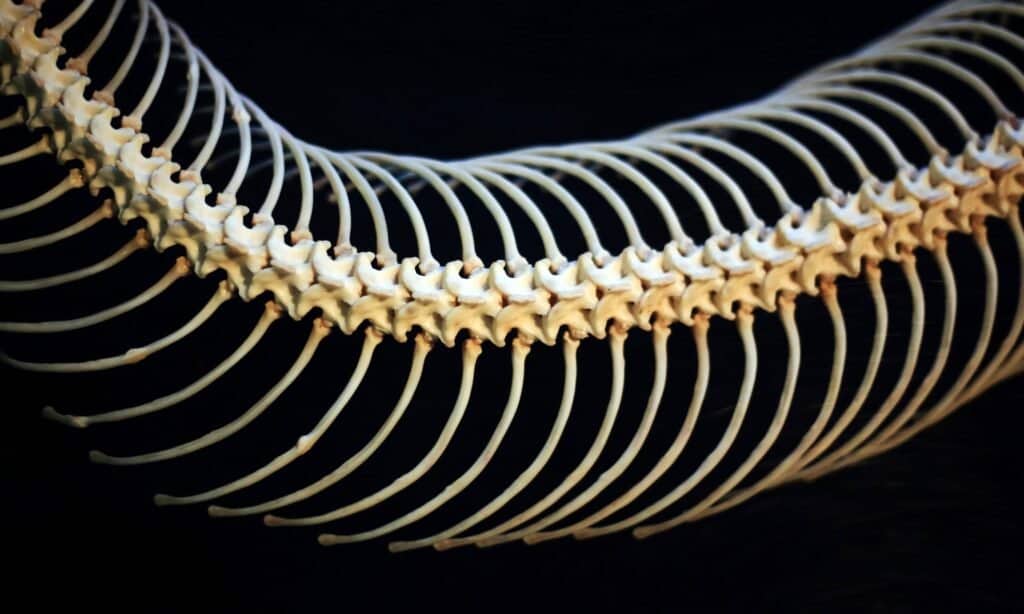
Snakes are vertebrates because they have a backbone.
©iStock.com/Baramee Temboonkiat
Snakes are vertebrates, snakes have a backbone! The snake skeleton is made of a series of connected bones that allow it to slither back and forth. Similar to humans, muscles are connected to the bones which are controlled by the nervous system and when a snake sees you come around the corner on a trial its brain sends a signal to the muscles to “move it!” and the snake can slither away.
How do snakes move?
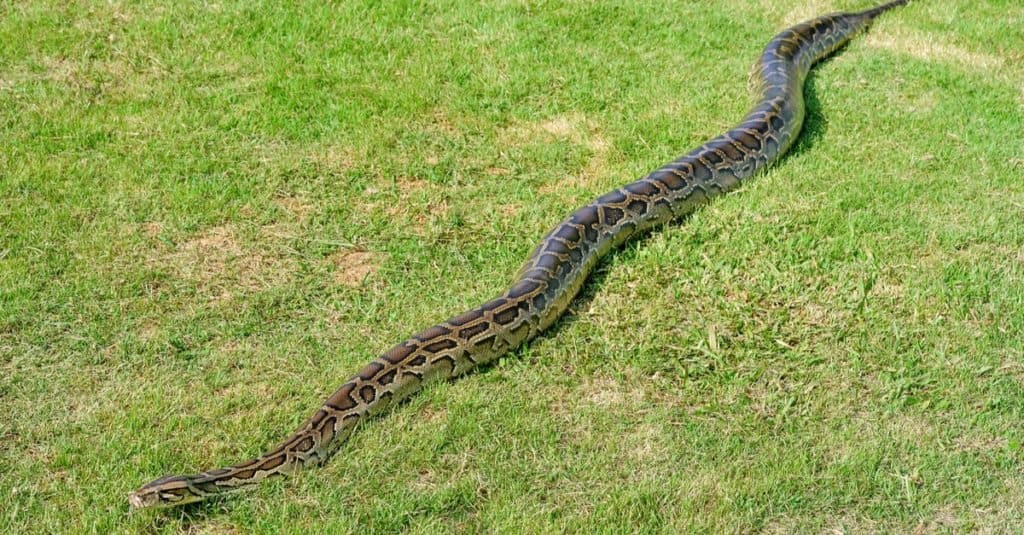
Burmese
Pythons and Boa Constrictors can move in a straight line without much effort. How do they do that?
©Yatra/Shutterstock.com
There are actually four different ways snakes move. Some can move in multiple ways whereas others stick to one primary movement. Think about a large boa constrictor that seems to float across the grass in a straight line, how do they do that? They use what is called rectilinear locomotion, contracting and relaxing muscles to create movement. There’s the sidewinder that slithers in an S-shape through the sand. The four kind of snake movement are:
- Concertina: this method is like an accordion where the snake secures its tail against some object and is able to push its body forward and then re-anchor itself.
- Serpentine: a method of slithers from side to side pushing off of things in the environment like rocks, raised ground
- Sidewinding: moving in a sideways “S” shape, usually through sand or loose soil, Sidewinder snakes and rattlesnakes will use this to get across hot sand without burning their scales
- Rectilinear locomotion: moving in a straight line, looks like it may be floating across the ground (large snakes like Boa’s and some Vipers)
How do boa constrictors constrict without breaking their back?
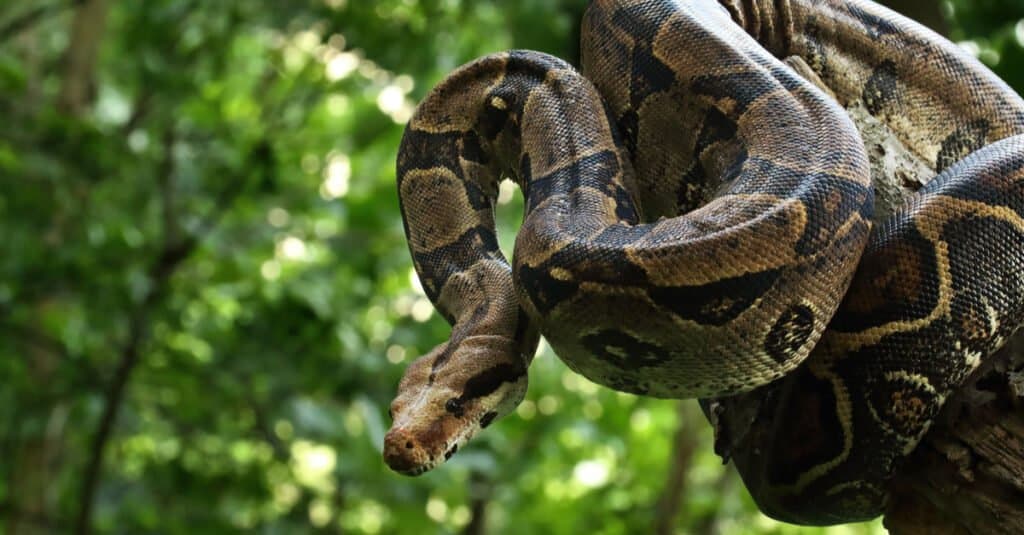
Boas
wrap thesmselves around their prey and squeeze until they die, then they eat them whole…head first!
©Jan Hejda/Shutterstock.com
A recent research study shows that large constrictor snakes are able to control the muscles along their ribs to squeeze their lungs in different areas to make sure it keeps breathing while constricting. The researchers called this “modular actuation” of the specific ribs. Similar controls of the muscles allow a boa to constrict without constricting so hard that it breaks its own back. Watch your own hand as you grab a pen, the muscles control the fingers and the hand to “constrict” the pen but won’t constrict so hard that your finger would break.
Are tiny blind snakes vertebrates?
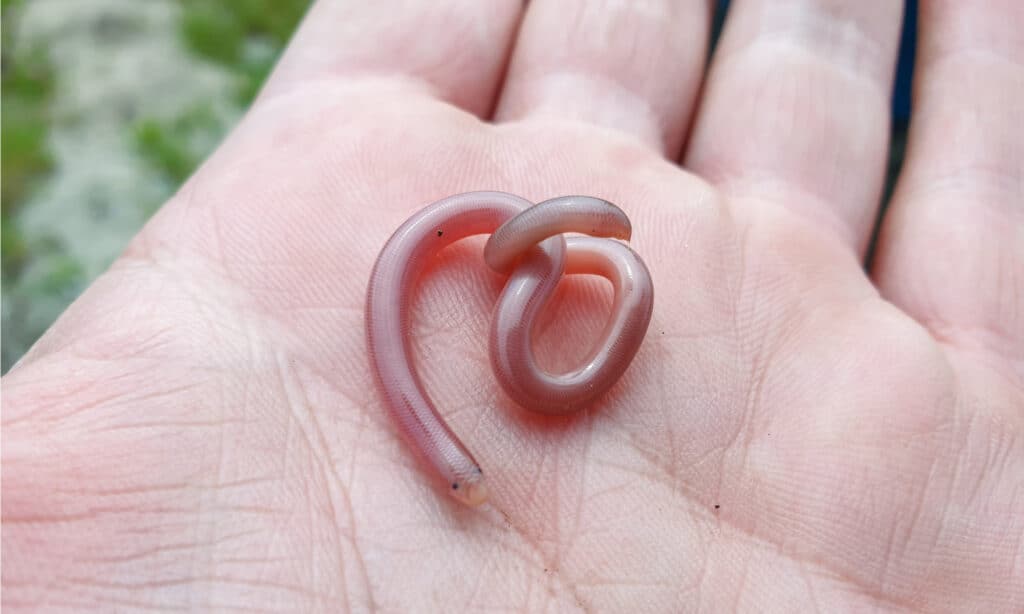
Tiny blind snakes have tiny backbones. Blind snakes are vertebrates.
©Willem Van Zyl/Shutterstock.com
Yes! Blind snakes may be tiny and look a lot like earthworms, but they actually have a backbone (a tiny one) just like other snakes. Blind snakes use the muscles and back bone to burrow into the sand and to move around underground in burrows.
How many vertebrae do humans have?
Humans have around 34 vertebrae that line the backbone and 24 ribs.
How many vertebrae do snakes have?
Snakes have 200-400 vertebrae! The vertebrae all connect on the top row of the snake and have 200-400 skinny ribs that protrude downward from each vertebrae. Having hundreds of small ribs and vertebrae is what makes them so flexible.
Do snakes have tails?
Snakes do have tails. It may look like the snake just comes to end but the end portion of their backbone is all bones and comes to a tip. Rattlesnakes have a rattle at the end of their tail but the rattle is not a part of the backbone it is actually of dead tissue. Baby rattlesnakes just have a button but as years go by more sections are added to the rattle and it gets longer.
Can snakes climb trees?

This
corn snake
is wrapped around a tree branch. Large ones can have as many as 400 bones in their bodies.
©iStock.com/bugphai
Most snakes can climb trees. Even rattlesnakes can slither around a tree trunk to make its way up the tree. Some snakes are arboreal, and live mostly in trees. Snakes like the Green Tree Python, Tree Boa and Rough Green snake are all arboreal snakes. Some will wrap their tails around tree branches to secure themselves while they strike prey.
Can snakes swim?
Did you know all snakes can swim? Even the largest Green Anaconda snake can swim, even though they can weigh more than 500 pounds! They are equipped to move through the water, side to side, to glide along the top of the water or to dive deep for food. Sea snakes and sea kraits have a paddle-like tail that they use to help them propel themselves through the water.
Are eels vertebrates, invertebrates or something else?
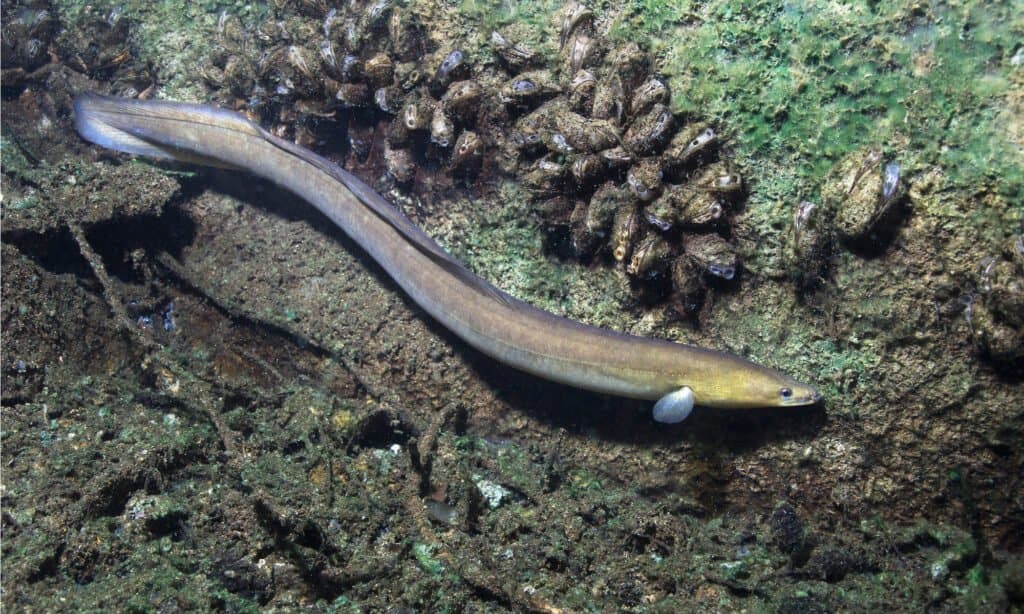
Eels are actually fish, so yes, eels are vertebrates.
©Rostislav Stefanek/Shutterstock.com
Talking about sea snakes, what about the eels that they share the ocean with. They look a lot like snakes, they even move similar to snakes, but are eels vertebrates? Eels are actually fish, and fish are vertebrates, so eels are vertebrates. They do have a backbone made of many tiny vertebrates which gives them the flexibility to swim through the ocean (and lakes/rivers for freshwater eels). They have around 100 vertebrae and a tail. One difference between sea snakes and eels is that sea snakes have scales and eels do not.
The photo featured at the top of this post is © iStock.com/Ken Griffiths
Discover the "Monster" Snake 5X Bigger than an Anaconda
Every day A-Z Animals sends out some of the most incredible facts in the world from our free newsletter. Want to discover the 10 most beautiful snakes in the world, a "snake island" where you're never more than 3 feet from danger, or a "monster" snake 5X larger than an anaconda? Then sign up right now and you'll start receiving our daily newsletter absolutely free.
Thank you for reading! Have some feedback for us? Contact the AZ Animals editorial team.






